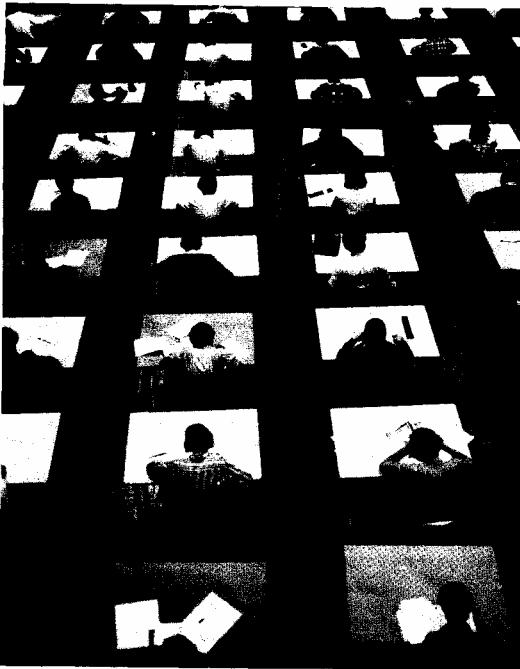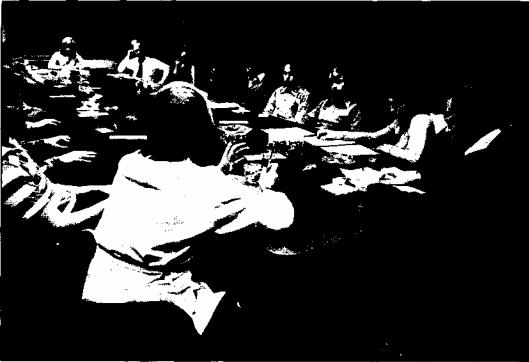
English_books / Beyond Language
.pdfFamily Values 107
Religious and secular holidays (Thanksgiving, Christmas, Easter, Passover, etc.)
Religious ceremonies (baptism, confirmation, bar/bat mitzvah) Weddings
Wedding anniversaries
Leisure activities (picnics, camping, dining out, movies)
6. Marriage: Usually the decision to marry is based on a mutual agree ment between the man and the woman. Parents may or may not be asked to give their permission. The marriage ceremony may be a simple visit to city hall, where marriage vows are exchanged and papers are signed, or it can be an elaborate religious/festive celebration. There are numerous alternatives to the traditional wedding ceremony.
Adoption: The practice of adopting children exists for parents who cannot have their own children, for parents who decide by choice not to have their own children, and for "single parents" (although it is difficult for single parents to adopt children). This practice is not considered unusual or negative in the American culture.
Separation: Couples who do not wish to get divorced may decide by mutual agreement to separate; in this case, they are still legally married. Couples who have filed for divorce are separated until the divorce is finalized.
Divorce: Divorces can be obtained easily in most American states. Either husbands or wives can apply for divorce. Bases for divorce can be as diverse as mutual agreement of "incompatibility" to accusations of brutal treatment. There is usually a minimal waiting time for remarriage. Child support payments, alimony, and the division of property are usually arranged by the courts or by mutual agreement between the husband and wife.
7. Some institutions in society are changing in order to help the family maintain close bonds. In some jobs pregnant women have "maternity leave" allowing them up to six months off the job with pay. Recently some jobs have been granting short "paternity leave" to men whose wives have delivered babies. In this way the man can take care of the house and child as the woman is recovering from delivery.
Supplementary Vocabulary and Phrases |
|
|
matriarchal |
juvenile |
ancestors |
patriarchal |
family income |
aged |
offspring |
lower-class family |
family tree |
puberty |
middle-class family |
marriage license |
adolescence |
upper-class family |
bride/groom |

6
Educational Attitudes
[A]Student life at American universities is chaotic during the first week
of each quarter or semester. Registering for classes, becoming familiar with the buildings on campus, buying books, adding and dropping
classes, and paying fees are confusing for everyone. During this busy 5 period there is little time for students to anticipate what they will later
encounter in the classroom.
[B] International students, accustomed to their countries' educational expectations, must adapt to new classroom norms in a foreign college or university. Whereas in one country prayer may be acceptable in a class room, in another it may be forbidden. In some classrooms around the
5 world students must humbly obey their teacher's commands and remain absolutely silent during a class period. In others, students may talk, eat, and smoke during lectures as well as criticize a teacher's methods or contradict his or her statements. It is not always easy to understand a new educational system.
Diversity in Education
[C] There is considerable variety in university classrooms in the United States. Because of diverse teaching methods and non-standardized curricula, no two courses are identical. Undergraduate courses are considerably different from graduate courses. The classroom atmosphere in 5 expensive, private universities may differ from that in community colleges which are free and open to everyone. State-funded universities have different requirements and expectations than do parochial colleges. Nevertheless, there are shared features in American college and university classrooms despite the diversity of educational institutions of higher
10 learning.
Active Participation
[DJ |
Participation in the classroom is not only accepted but also expected |
|
of the student in many courses. Some professors base part of the final |
|
109 |

grade on the student's oral participation. Although there formal lectures during which the student has a passive role (i.e., listening and 5 taking notes), many courses are organized around classroom discussions, student questions, and informal lectures. In graduate seminars the professor has a "managerial" role and the students make presentations and lead discussions. The students do the actual teaching in these seminars.
[E]A professor's teaching style is another factor that determines the degree and type of student participation. Some professors prefer to control discussion while others prefer to guide the class without dominating it. Many professors encourage students to question and challenge 5 their ideas. Students who make assertions that contradict the professor's point of view should be prepared to substantiate their positions.
[F]In the teaching of science and mathematics, the dominant mode of instruction is generally traditional, with teachers presenting formal
lectures and students taking notes. However, new educational trends have emerged in the humanities and social sciences in the past two 5 decades. Students in education, sociology/and psychology classes, for example, are often required to solve problems in groups, design projects, make presentations, and examine case studies. Since some college or university courses are "applied" rather than theoretical, they stress
"doing" and involvement.
110

Educational Attitudes 111
The Teacher-Student Relationship
[G]Many instructors believe that an informal, relaxed classroom environment is conducive to learning and innovation. It is not uncommon for students to have easygoing and friendly relationships with their professors. The casual professor is not necessarily a poor one and is still 5 respected by students. Although students may be in a subordinate position, some professors treat them as equals. However, no matter how egalitarian professors would like to be, they still are in a, position of authority
[H]Professors may establish social relationships with students outside of the classroom, but in the classroom they maintain the instructor's role. A professor may have coffee one day with students but the next day expect them to meet a deadline for the submission of a paper or to be 5 prepared for a discussion or an exam. The professor may give extra attention outside of class to a student in need of help but probably will not treat him or her differently when it comes to evaluating school work. Professors have several roles in relation to students; they may be counselors and friends as well as teachers. Students must realize that when a 10 teacher's role changes, they must appropriately adapt their behavior and attitudes.

112 Educational Attitudes
Independent Learning
[I] Many teachers believe that the responsibility for learning lies with the student. If a long reading assignment is given, instructors expect students to be familiar with the information in the reading even if they do not discuss it in class or give an examination. (Courses are not 5 designed merely for students to pass exams.) The ideal student is considered to be one who is motivated to learn for the sake of learning, not the one interested only in getting high grades. Grade-conscious students may be frustrated with teachers
who do not believe it is necessary to |
grade every assignment. Sometimes |
homework is returned with brief 10 |
written comments but without a grade. |
|
Even if a grade is not given, the |
student is responsible for learning the material assigned.
[J] When research is assigned, the professor expects the student to take the initiative and to complete the assignment with minimal guidance. It is the student's responsibility to find books, periodicals, and articles in the library. Professors do not have the time to explain how a university
5 library works; they expect students, particularly graduate students, to be able to exhaust the reference sources in the library.
[K] Professors will help students who need it, but prefer that their students not be overly dependent on them. (This differs from teacherstudent relationships in other countries.) In the United States, professors have other duties besides teaching. Often they are responsible for admin-5 istrative work within their departments. In addition, they may be obliged to publish articles and books. Therefore the time that a professor can
Educational Attitudes |
113 |
spend with a student outside of class is limited. If a student has problems with classroom work, the student should either approach a professor during office hours or make an appointment.
The Honor System
[L] Ideally, the teacher-student relationship at universities is characterized by trust. The "honor system," imposed by the teacher and the university, demands that the student be honest in all areas of school work. Thus, cheating on tests, plagiarizing in written work, presenting
5others' ideas as original, and turning in homework completed by someone else are all prohibited.
[M]Violation of the honor system can result in a student's failing a course, having a permanent record of the violation placed in the student's school files, or even being expelled from the university. Many students are also aware that they can jeopardize their rapport with fellow students if they
5are dishonest. Students who cheat may lose the respect of other students, particularly those who study for exams and work independently. When leaving the classroom while students are taking an exam, an instructor may or may not say, "I expect you all to abide by the honor system." Even if the words are not stated, the student is expected to work alone and not 10 to share answers.
Competition
[N] Relationships between students in the classroom can be cooperative or competitive. International students should not hesitate to ask for help if it is needed. There are courses, however, where grades are calculated in relation to other students' scores. Therefore, in classes where such a
5 grading "curve" is used, students may be reluctant to share lecture notes or information for fear that their own grades will suffer.
[O] There are other reasons for the presence of competition among students. A high grade point average is needed for entrance to superior graduate schools. Students feel pressure to achieve high grades when there are relatively few openings in graduate programs. In addition, 5 when facing a competitive job market, graduates may be judged on the basis of their grade point average and faculty
recommendations. Ultimately, it is the student who is responsible for succeeding in this competitive system.
* |
* |
* |
* |
* |
[P] The university classroom in the United States manifests cultural values through professors and students' expectations and attitudes: Competi-

114 Educational Attitudes
tion is an example of only one value. Educational practices such as the honor system and student participation indicate a respect for individual 5 responsibility and independence. Alternative teaching methods show a cultural preference for innovation. The manner in
which education is provided in any country reflects basic cultural and social beliefs of that country.
Educational Attitudes 115
Comprehension Questions91
Choose the best answer for the following questions. You will find the answer either stated directly or indirectly in the reading passage.
1.What is the main theme of this reading?
a.Academic success in universities in the United States.
b.Behavior, attitudes, and values found in the American university.
c.Competition in American society.
2."Participation in the classroom is not only accepted but also expected of the student" in many courses except: [D]
a.Seminar courses. b.
Formal lecture courses.
Informal lecture courses.
116Educational Attitudes
b.Students never to seek professors' advice.
c.Students to take the initiative and be independent.
7.If a professor believes in the "honor system," it implies: [L] and [M]
a.Suspicion of the students.
b.Distrust of the students.
c.Trust of the students.
8.It is not surprising to find competition among students because: [O] and [P]
a. Competition is better than cooperation. b.
Competition is a dominant American value. c.
Competition is encouraged in sports.
9.What American values does the university system reflect? [P]
a.Democracy, socialism, and authoritarianism. b. Absolute respect, formality, and tradition.
c.Individual responsibility, independence, and innovation.
Vocabulary List
Paragraph A |
Paragraph B |
Paragraph C |
Paragraph D |
chaotic |
accustomed |
diverse |
(no new words) |
|
*norms |
standardized |
|
|
forbidden |
*curricula |
|
|
*humbly |
*parochial |
|
|
*contradict |
|
|
Paragraph E |
Paragraph F |
Paragraph G |
Paragraph H |
assertions |
design |
*conducive |
deadline |
substantiate |
theoretical |
innovation |
treat |
|
stress |
subordinate |
|
|
|
egalitarian |
|
|
|
authority |
|
|
|
discipline |
|
Paragraph 1 |
Paragraph J |
Paragraph K |
Paragraph L |
(no new words) |
*periodicals |
administrative |
cheating |
|
exhaust |
|
plagiarizing |
|
|
|
*prohibited |
*See vocabulary exercise D.
